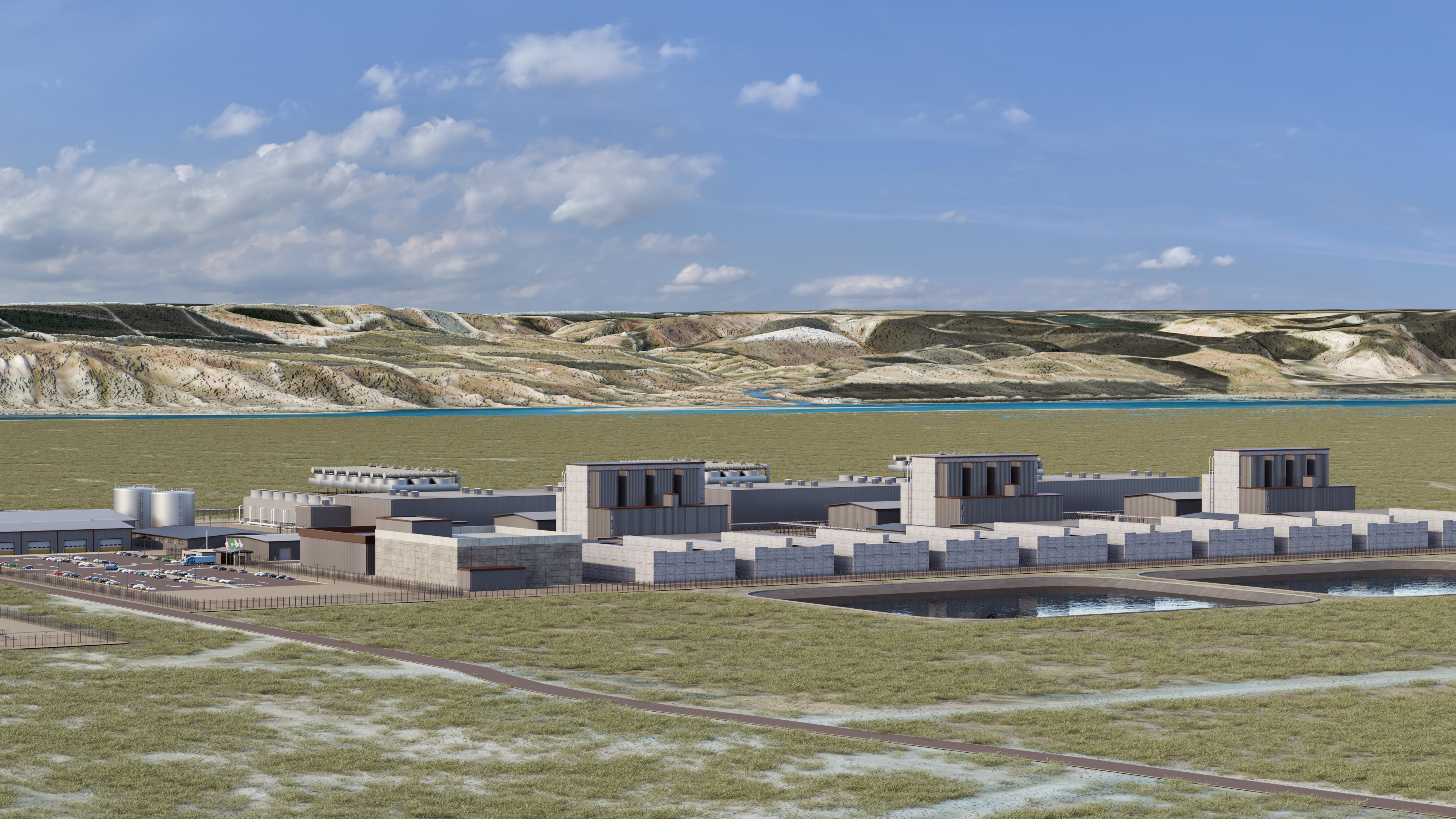Amazon reveals 960 megawatt nuclear power plans to cope with AI demand — Richland, Washington site tapped for deployment of Xe-100 small modular reactors
The Cascade Advanced Energy Facility would use next-gen Xe-100 reactors to deliver 960 megawatts of carbon-free power — but it’s years from becoming reality.

Amazon has revealed plans to help build one of the United States’ first modular nuclear power campuses in a move designed to supply carbon-free electricity for its growing AI and cloud workloads.
Announced on October 16, the new Cascade Advanced Energy Facility will be located in Richland, Washington, near the Columbia Generating Station. The site, developed with local utility Energy Northwest, is expected to enter construction by the end of the decade and begin generating power sometime in the 2030s, pending regulatory approval and financing.
The facility will use Xe-100 small modular reactors from X-energy, each rated at 80 megawatts. The initial phase will deploy four reactors for a combined 320 megawatts, with room to scale up to 12 units delivering 960 megawatts. Amazon says the project is part of its broader push to secure access to clean power for its AWS data centers and generative AI clusters, which are becoming major industrial-scale energy consumers.
While Amazon’s involvement makes this one of the most concrete SMR proposals yet tied to AI infrastructure, the project is still in early development. The Xe-100 reactor is undergoing pre-application review at the U.S. Nuclear Regulatory Commission, and no construction permits have yet been granted. Energy Northwest and X‑energy are expected to lead licensing and engineering for the Cascade project, and the partners have said they’re exploring federal support through the U.S. Department of Energy’s loan programs.
Last year, Amazon invested in X-energy through its Climate Pledge Fund and separately acquired a data center campus adjacent to a nuclear plant in Pennsylvania. But Cascade is the first time Amazon has publicly committed to helping bring new nuclear generation online—something no hyperscaler has yet achieved.
The project could be a litmus test for the future of SMRs. Advocates argue that advanced reactors like the Xe-100 can be built faster than traditional nuclear plants, with modular designs that better suit today’s distributed grid. But the 2023 collapse of NuScale’s Idaho SMR project — canceled after costs ballooned and subscribers dropped out — highlights significant risks.
Amazon hasn’t disclosed how much of Cascade’s output it plans to use, but U.S. data center power requirements could triple by 2030 and account for 9% of electricity demand by 2035, driven largely by generative AI and accelerated compute. Amazon appears to be betting that if it wants a guaranteed, zero-carbon supply for that future, it may need to build the grid itself.
Get Tom's Hardware's best news and in-depth reviews, straight to your inbox.

Follow Tom's Hardware on Google News, or add us as a preferred source, to get our latest news, analysis, & reviews in your feeds.

Luke James is a freelance writer and journalist. Although his background is in legal, he has a personal interest in all things tech, especially hardware and microelectronics, and anything regulatory.
-
S58_is_the_goat Nuclear power plants for everybody, you're not a true ai tech bro until you own a few nuclear power plants 🫠Reply -
DS426 ReplyThis article:
Yes, please do Amazon and others, rather than placing that burden on local and regional communities. Actually, it's not even building a grid, just powering one's own hungry datacenters. Not having those longer transmission distances is ideal when talking about hundreds of megawatts of power.
Amazon appears to be betting that if it wants a guaranteed, zero-carbon supply for that future, it may need to build the grid itself. -
urn66 OK, but this is years away as China scales SMRs based on proven Thorium MSR technology with demonstrated live fuel exchange.Reply
Good to see US finally getting into the game, but trailing China and EU (Copenhagen Atomics) here.
SCMP - China has world’s first operational thorium nuclear reactor thanks to ‘strategic stamina’ -
93QSD5 Funny enough, this game is a perfect depiction of the A.I. craze right now.Reply
https://store.steampowered.com/app/2276980/FACEMINER/
The best quote in the game: "What are we even harvesting this data for? What is the point of this?" -
Amdlova That's nice... No carbon emission, Only tons of water vapor and more water vapor on swamp coolers...Reply
I think every one need to buy a boat. because the rivers now will be in the sky. -
blppt Somewhat amusingly, that plant rendering bears a vague resemblance to Chernobyl. Superficially, of course, but still worth a chuckle.Reply -
LordVile Reply
No one cares about china. Thorium reactors still require uranium and the supply chain limitations for fuel make them a non starter.urn66 said:OK, but this is years away as China scales SMRs based on proven Thorium MSR technology with demonstrated live fuel exchange.
Good to see US finally getting into the game, but trailing China and EU (Copenhagen Atomics) here.
SCMP - China has world’s first operational thorium nuclear reactor thanks to ‘strategic stamina’
They’re also less efficient and require more shielding, which also needs replacing. -
93QSD5 Reply
Supply chain limitation? what exactly do you mean by that? Especially given the greater abundance of thorium (3x than uranium), as well as china's warmongering frenemy sitting on lots of uranium.LordVile said:No one cares about china. Thorium reactors still require uranium and the supply chain limitations for fuel make them a non starter.
They’re also less efficient and require more shielding, which also needs replacing.
Thorium by-product has a lesser potential to be made weapons grade.
Two orders of magnitude less high level nuclear waste.
What is your data on the efficiency part?
According to CERN, one ton of thorium can produce as much energy as 200 tons of uranium.
Or are you refering to the higher melting point of thorium dioxide to produce thorium dioxide fuel? I'm not sure what you mean.
Breeding reactors produce at least as much fissile material as they consume
They are also safe(r) which is all that matters tbf.
On top of that, if I'm not mistaken, the waste only lingers around for hundreds of years comp. to traditional current ones which produce waste that needs to be stored for thousands of years.
Waste and safety are the actual issues. Everything else is debatable (costs vs time etc.).
You realize that we still don't have a solution for nuclear waste right?
Everyone has lost their minds about opting out of nuclear, yet nobody can ever answer, what do you do with the waste? (stashing it into the poor earth, engulfing the barrels in other materials in some forsaken place IS NOT a solution. On top of that, there are flimsy on-ground facilities, right now, which house current waste waiting for a long term storage or solution. What do you do about those?
Nuclear is only clean when you willingly and blindly ignore, the dirty mining and unthinkably lasting waste (for which we don't have a solution other than diging holes and stuffing it in, praying for the best...
Everyone keeps talking about (oh nucelar is safe, RMBK was an exception). If nature won't do it, humans will. Japan, Chernobyl, Belgium, Three Mile Island, ...
A monkey would notice a pattern at this point. Risk-to-reward.
We have seen the extreme damages of what occurs in (almost) worst cases. And all it takes is one genuis to earn the titel of actual worst case.
PS: I'm not necessarily against nuclear. Quite the opposite, but we need to start being more honest instead of passing the buck around. -
sygreenblum Reply
China has 1 experimental Thorium reactor producing a minuscule 2 megawatt's with a second tiny 10 megawatt reactor expected to come online in 2030.urn66 said:OK, but this is years away as China scales SMRs based on proven Thorium MSR technology with demonstrated live fuel exchange.
Good to see US finally getting into the game, but trailing China and EU (Copenhagen Atomics) here.
SCMP - China has world’s first operational thorium nuclear reactor thanks to ‘strategic stamina’
They expect small 100 megawatt reactors to start construction sometime after 2030 but have given no specifics mainly because they have yet to solve some of the fundamental problems associated with thorium reactors. This is mainly corrosion, handling of high gamma emitting waste, repossessing of salts, and reactor degradation.
I have 3 family members that work in the nuclear industry. Two cousins in Hanford working on disposal and my brother at Diablo Canyon nuclear power plant and they take the believe when I see it approach to commercial thorium reactors. Below is a link to a pretty neutral and I'd say realistic take, without all the hype.
g6r1kIZ3HNc:71View: https://www.youtube.com/watch?v=g6r1kIZ3HNc&t=71s